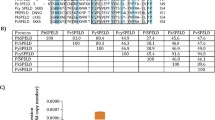Abstract
The CSP, EMP2/MESA, MSP2, MSP3, MSP5, RAP1, RAP2, RESA1, SERA1 and SSP2/TRAP genes of Plasmodium falciparum are vaccine candidates. The hepatic phase of the infection is of major interest due to the protection induced by immunization with radiation-attenuated sporozoites. We therefore performed RT-PCR experiments to determine whether these genes are transcribed during this phase. Whereas transcripts of the CSP gene were detectable only in sporozoites, transcripts of the MSP2, MSP5, RAP1, RAP2, SERA1 and SSP2/TRAP genes were present in both sporozoites and infected hepatocytes. Transcripts of the EMP2/MESA gene were detectable only in infected hepatocytes. Transcripts of the MSP3 and RESA1 genes were not detectable in sporozoites or in infected hepatocytes. Genes presently identified as being transcribed during the hepatic phase may be of interest with respect to the design of preventative vaccination strategies.

Similar content being viewed by others
References
Bahl A, Brunk B, Crabtree J, et al (2003) PlasmoDB: the Plasmodium genome resource. A database integrating experimental and computational data. Nucleic Acids Res 31:212–215
Clyde DF, McCarthy VC, Miller RM, Hornick RB (1973) Specificity of protection of man immunized against sporozoite-induced falciparum malaria. Am J Med Sci 266:398–403
Daubersies P, Thomas AW, Millet P, et al (2000) Protection against Plasmodium falciparum malaria in chimpanzees by immunization with the conserved pre-erythrocytic liver-stage antigen 3. Nat Med 6:1258–1263
Florens L, Washburn MP, Raine JD, et al (2002) A proteomic view of the Plasmodium falciparum life cycle. Nature 419:520–526
Gardner MJ, Hall N, Fung E, et al (2002) Genome sequence of the human malaria parasite Plasmodium falciparum. Nature 419:498–511
Gruner AC, Snounou, G, Brahimi K, Letourneur F, Renia L, Druilhe P (2003) Pre-erythrocytic antigens of Plasmodium falciparum: from rags to riches? Trends Parasitol 19:74–78
Hoffman SL, Goh LM, Luke TC, et al (2002) Protection of humans against malaria by immunization with radiation-attenuated Plasmodium falciparum sporozoites. J Infect Dis 185:1155–1164
Kappe SH, Gardner MJ, Brown SM, et al (2001) Exploring the transcriptome of the malaria sporozoite stage. Proc Natl Acad Sci U S A 98:9895-9900
Le Roch KG, Zhou Y, Blair PL, et al (2003) Discovery of gene function by expression profiling of the malaria parasite life cycle. Science 301:1503–1508
Mazier D, Beaudoin RL, Mellouk S, et al (1985) Complete development of hepatic stages of Plasmodium falciparum in vitro. Science 227:440–442
Moore SA, Surgey EG, Cadwgan AM (2002) Malaria vaccines: where are we and where are we going? Lancet Infect Dis 2:737–743
Richie TL, Saul A (2002) Progress and challenges for malaria vaccines. Nature 415:694–701
Rieckmann KH, Beaudoin RL, Cassells JS, Sell KW (1979) Use of attenuated sporozoites in the immunization of human volunteers against falciparum malaria. Bull World Health Organ 57 [Suppl 1]:261–265
Sacci JB, Azad AF (2002) Gene expression analysis during liver stage development of Plasmodium. Int J Parasitol 32:1551–1557
Semblat JP, Silvie O, Franetich JF, Hannoun L, Eling W, Mazier D (2002) Laser capture microdissection of Plasmodium falciparum liver stages for mRNA analysis. Mol Biochem Parasitol 121:179–183
Silvie O, Semblat JP, Franetich JF, Hannoun L, Eling W, Mazier D (2002) Effects of irradiation on Plasmodium falciparum sporozoite hepatic development: implications for the design of pre-erythrocytic malaria vaccines. Parasite Immunol 24:221–223
Trager W, Jensen JB (1976) Human malaria parasites in continuous culture. Science 193:673–675
Tsuji M, Zavala F (2003) T cells as mediators of protective immunity against liver stages of Plasmodium. Trends Parasitol 19:88–93
World Health Organisation (1997) World malaria situation in 1994. Part I. Population at risk. Wkly Epidemiol Rec 72:269–274
Acknowledgement
We are grateful to Christian Doerig for critically reading the manuscript.
Author information
Authors and Affiliations
Corresponding author
Rights and permissions
About this article
Cite this article
Bodescot, M., Silvie, O., Siau, A. et al. Transcription status of vaccine candidate genes of Plasmodium falciparum during the hepatic phase of its life cycle. Parasitol Res 92, 449–452 (2004). https://doi.org/10.1007/s00436-003-1061-9
Received:
Accepted:
Published:
Issue Date:
DOI: https://doi.org/10.1007/s00436-003-1061-9




